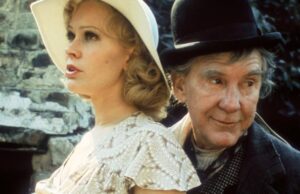The Women (1939)

Toronto Film Society presented The Women (1939) on Monday, March 12, 1984 in a double bill with Madame Butterfly as part of the Season 36 Monday Evening Film Buffs Series “B”, Programme 8.
Production Company: M-G-M. Producer: Hunt Stromberg. Director: George Cukor. Screenplay: Anita Loos and Jane Murfin, from the play by Clare Boothe. Photography: Oliver T. Marsh and Joseph Ruttenberg. Editor: Robert J. Kern. Art Directors: Cedric Gibbons and Wade B. Rubottom. Sets: Edwin B. Willis. Costumes: Adrian. Music: Edward Ward and David Snell.
Cast: Norma Shearer (Mary Haines), Joan Crawford (Crystal Allen), Rosalind Russell (Sylvia Fowler), Mary Boland (Flora de Lave), Paulette Goddard (Miriam Aarons), Joan Fontaine (Peggy Day), Virginia Weidler (Mary), Marjorie Main (Lucy), Lucile Watson (Mrs. Morehead), Phyllis Povah (Edith Potter), Ruth Hussey (Miss Watts), Margaret Dumont (Miss Wagstaff), Dennie Moore (Olga), Esther Dale (Ingrid), Hedda Hopper (Dolly Dupuyster), Florence Nash (Nancy Blake), Ann Morriss (Exercise Instructress), Mary Beth Hughes (Miss Trimmerback), Virginia Grey (Pat), Cora Witherspoon (Mrs. Van Adams), Aileen Pringle (Dress Saleswoman), Judith Allen (Model).

The Women employs a large, all-female cast which reads like a who’s who in Hollywood in the late 30’s for this Anita Loos adaptation of Claire Boothe’s play.
It’s the story of Mary Haines (Norma Shearer), a warm, womanly essentially kind-hearted wife and mother. But, she is surrounded by a witchy social set. And, the “Witches’ Congress” as it’s known knows something that Mary doesn’t know…that her husband Stephan is having an an affair with Crystal Allen (Joan Crawford) an ambitious shop-girl. But, they see to it that Mary eventually does know, and then the plot thickens.
Reviewers were in agreement that the transformation of the Broadway play to the screen had been successfully undertaken. The New York Herald Tribune notes, “Some of the venom of the play has been extracted, while Miss Boothe’s sentimental consideration of the heroine has become even more sentimental. What will matter to most filmgoers is that the show is caustically comic, that it has enlisted a slew of Hollywood’s top actresses and that George Cukor has saturated the proceedings in femininity.”
Frank Nugent in the New York Times, heaps praise on the production, “The tonic effect of The Women is so marvelous we believe every studio in Hollywood should make at least one thoroughly nasty picture a year. Miss Boothe has dipped her pen in venom and written a comedy that would turn a litmus paper pink. MGM, without alkalizing it too much, has fed it to a company of actresses who normally are so sweet that butter wouldn’t melt in their mouths. And, instead of gasping and clutching at their throats, the women–bless ’em–have downed it without blinking…and gone on a glorious cat-clawing rampage…and turned in one of the merriest pictures of the season. We don’t know when we’ve seen such a terrible collection of women…they’re really appallingly good, and so is their picture.”
For Joan Crawford, the film provided a turning point in her career. The early “fluff” days had gone, she was at a period of decline in her career, and in early 1938 a trade paper had labelled her “box office poison”. The career seemed to stabilize in late 1938 when she starred with Melvyn Douglas, Margaret Sullavan and Robert Young in The Shining Hour, but then fell off again after an “epic” titled Ice Follies of 1939.
But, eager for a change, and a challenge, she begged for the part of Crystal in The Women. And, that persistence finally convinced Cukor, producer Hunt Stromberg and Louis B. Mayer she should have the role.
Crawford says Cukor was “a hard taskmaster, a painstaking director, and he took me over the coals, made me rehearse over and over, not just lines, but even words. He gave me the roughest time I ever had, and I’m eternally grateful.”
Cukor made her concentrate on voice and projection and the “new” Crawford more than held her own with talents such as Norma Shearer, Rosalind Russell and Mary Boland.
Off-screen, Director Cukor proved a successful lion-tamer with his cage full of women, with only one reported clash, between Crawford and Norma Shearer.
Director George Cukor had come to Hollywood in 1929, and had a rather checkered career…from the highs of Camille, with Greta Garbo in 1937…to the lows of Two Faced Woman in 1941, which was probably her (Garbo’s) worst film.
But, he was also behind the megaphone for the likes of Bill of Divorcement (1932), Dinner at Eight (1933), A Double Life (1947), Born Yesterday (1950), A Star Is Born (1954), and My Fair Lady, which in 1964 won Cukor his first Oscar.
And, there’s an added bonus from MGM in the tradition of the time, as they added a Technicolor fashion show to The Women.
Notes by Bill Sturrup










Leave a Reply